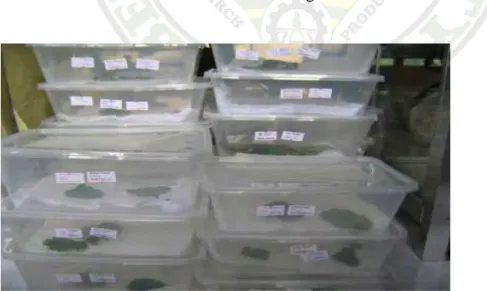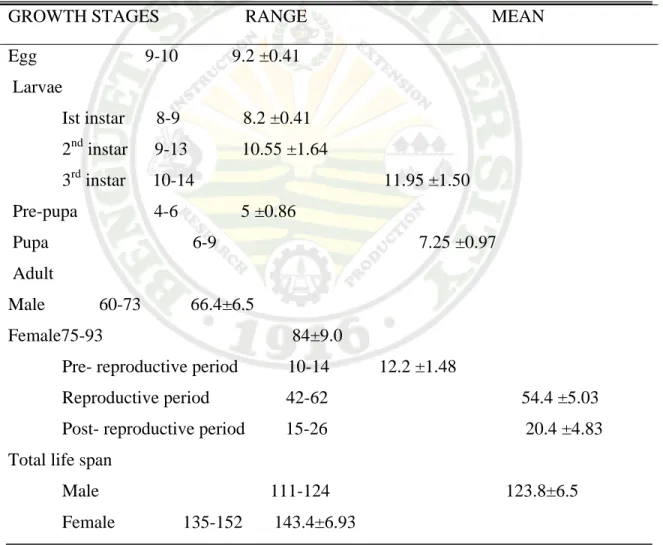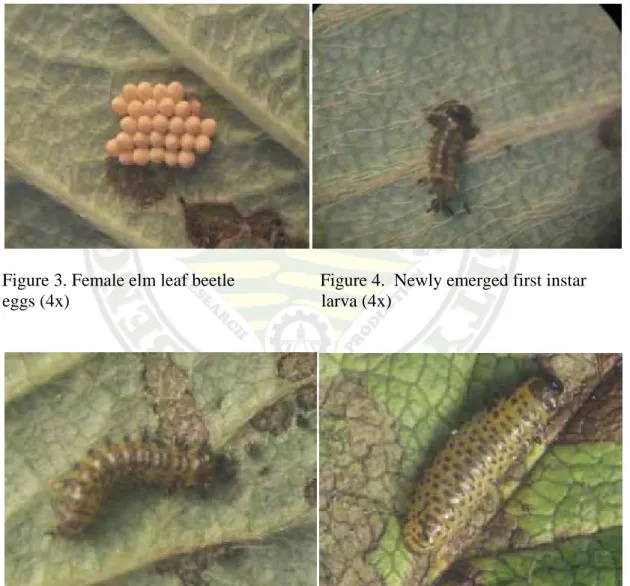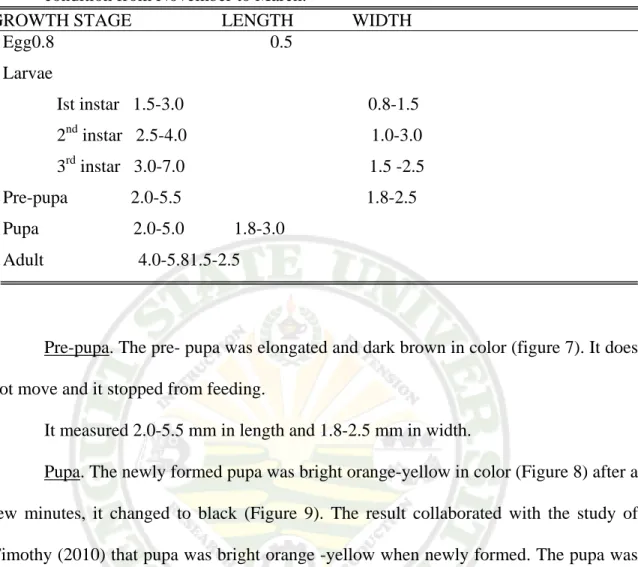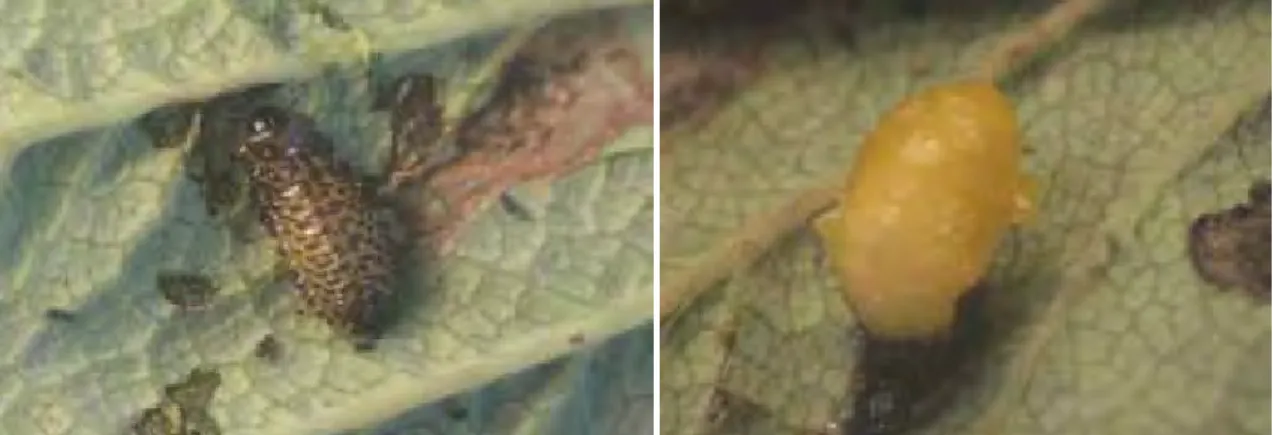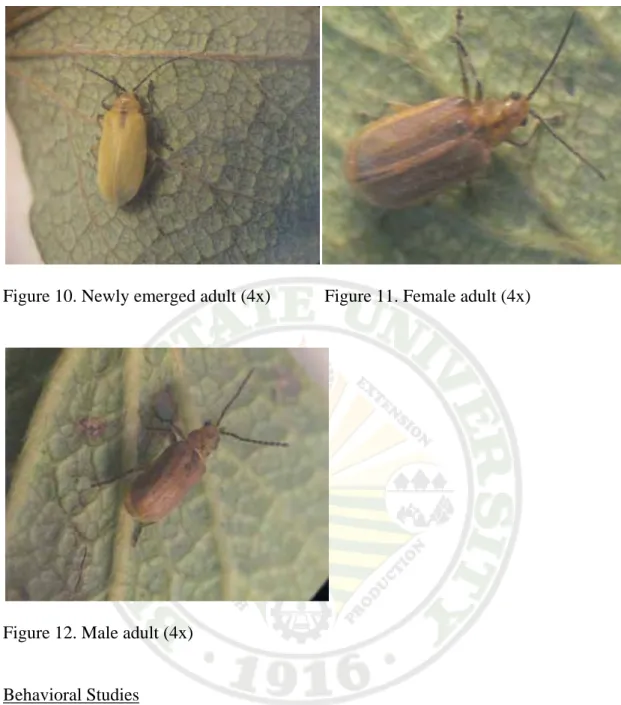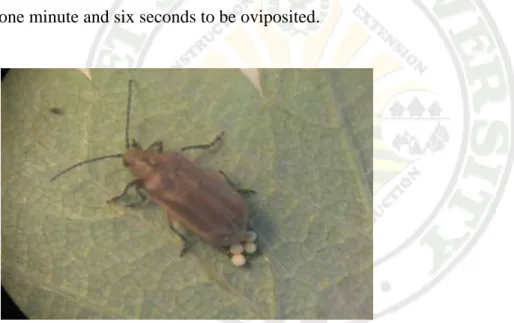BINWIHAN, MARIBELLE T. APRIL 2012. Biology of Elm Leaf Beetle(Pyrrhaltaluteola Muller) (Coleoptera: Chrysomelidae) on Strawberry. Benguet State University, La Trinidad, Benguet.
Adviser: Maria Ana C. Tanyag, MSc.
ABSTRACT
The study was conducted at the Benguet State University, Mites Predatory Rearing House, Balili La Trinidad, Benguet from November 2011 to March 2012, to determine the duration and morphological characteristics of the different growth stages of the elm leaf beetle, determine the feeding, mating and oviposition behavior, fecundity and to identify its alternative hosts plants.
The developmental stages and duration of the different growth stages were as follows:
Egg: 9-10 days with a mean of 9.2±0.41 days, first instar larva: 8-9 days with a mean of 8.2±0.41 days, second instar larva: 9-13 days with a mean of 10.55±1.64 days, third instar larva: 10-14 days with a mean of 11.95±1.50 days, pre-pupa: 4-6 days with a mean of 5±0.97 days, Pupa: 6-9 days with a mean of 7.25±0.97 days. Male adult longevity was 60-73 days with a mean of 66.4±6.5 days and 75-93 days with a mean of 84±9.0 days for the female. Life span of male was 111-124 days with a mean of 123.8±6.5 days and 135-152 days with a mean of 143.4±6.93 days for the female.
The egg was yellowish - orange and lemon shaped which measured 0.8 mm long and 0.5 mm in width. The larva was yellowish -green and alligator-like. The first instar larva measured 1.5-3.0 mm long and 0.8-1.5 mm in width, second instar was 2.5- 4.0 mm long and 1.0-3.0 mm in width, third instar larva was from 3.0-7.0 mm long and of 1.5- 2.5 mm width. The pre-pupa
black in color and round in shape which measured 2.0-5.0 mm long and 1.8 -3 mm in width. The body of adult elm leaf beetle was yellowish-green with brown wing cover. It has black eyes, black antennae, yellowish-green legs and with black spots on the thorax and at the base of the wing cover. The body length measured 4-5.8 mm in length and 1.5-2.5 mm in width.
The adult and larvae of elm leaf beetle fed by means of their chewing mouthparts aided by the bending of their head when chewing the leaves.
The adult used its legs to hold and grip the female aided by the wagging of antennae when mating. Mating occurred anytime of the day which lasted for an average of 40 minutes.
Male adult mated 2-4 times a day.
The female adult elm leaf beetle oviposited eggs by positioning its head downward and slightly raising up its abdomen. Eggs are deposited in clusters of about 5 to 35 on the undersides of the leaves.
It can lay as many as 516 to 722 eggs during its lifetime.
The alternative host plants were the Rumexcrispus L. and an unknown species.
Page
Bibliography………. i
Abstract . . . .………... i
Table of Contents………. iii
INTRODUCTION……….. 2
REVIEW OF LITERATURE……….. 5
MATERIALS AND METHODOLOGY……… 10
RESULTS AND DISCUSSION Duration of Growth Stages ……….. 12
Morphological Characteristics ………. 15
Behavioral Studies……… 17
Fecundity……….. 18
Host Range……… 18
SUMMARY, CONCLUSION AND RECOMMENDATION Summary……… 19
Conclusion ………. 20
Recommendation……….. 20
LITERATURE CITED………... 21
APPENDICES……….. 34
INTRODUCTION
Beetles of the family chrysomelidaeare commonly known as leaf beetles. Nearly ten percent of all known beetle species are leaf beetles. Although relatively small, many species attractattention because of their striking body patterns and brilliant colors.
However, large populations can destroy foliar displays. As their common name implies, adult leaf beetles and their larvae feed on plant foliage. Elm treesare attacked by elm leaf beetles (Timothy, 2010)
Elm leaf beetle (Pyrrhaltaluteola Muller) is a serious insect damaging urban forest in the United States and is the major pest of elm trees in California. Its larva damages the plants by skeletonizingthe leaf surfaces while the adult chew entirely through the leaf often in a shot hole pattern. Defoliation eliminates summer shade, reduces the aesthetic value of trees and cause annoying leaf drop. Repeatedly extensive defoliation weakens elms cause the trees to decline (Dreistadt, 2008). In Benguet particularly La Trinidad, it was found infesting strawberry plants (Ligat, 2011).
Considering that strawberry is a common crop in Benguet the study of this elm leaf beetle is necessary.
The study on the biology of this elm leaf beetle is an important guide toattain themost reliable and effective management strategies in controlling this pest. This will give information for conducting researchable studies about this beetle.
The objectives of the study were to determine the duration and morphological characteristics of the different growth stages of the elm leaf beetle, determine the feeding, mating and oviposition behavior,fecundity and its alternative host plant.
The study was conducted at the Mites Predatory Rearing House, Balili La Trinidad Benguet from November 2011 to March 2012.
REVIEW OF LITERATURE
Biology
According to Baker (2000) that elm leaf beetle was introduced from Europe in 1838 and is now found throughout the United States. Elm leaf beetles feed on all elms but tend to prefer English elms. Damage is most noticeable in landscape trees. The elm leaf beetle is considered the most serious elm defoliator in the United States. Larvae skeletonize leaves which then turn brown and may defoliate prematurely. Adults chew irregular holes in the leaves. Heavily infested trees may be weakened or even killed after repeated attacks. In fall, adults may be a nuisance as they crawl into buildings seeking an overwintering site. Elm leaf beetles overwinter as adults. As the buds on elms start to swell in spring, the beetles begin to emerge. Females begin laying eggs in late May and over the next several weeks, deposit 400 to 800 eggs each in clusters of two or three rows. Eggs are usually place near the midrib on the underside of leaves. About a week later, they hatch into tiny larvae which skeletonize the leaves by feeding on the lower surface but leaving a thin layer of the upper surface intact. The larvae mature in two or three weeks at which time they drop to the ground to pupate under litter or some other shelter near the base of the tree. A new generation of adults emerges in about ten days.
Many of the beetles which emerge during the summer months seek places for hibernation early in the season.
Morphological Characteristics
Drees and Jackman (1999) stated that adult beetles are approximately ¼ inch long and yellowish or greenish with black outer margins on the wing covers. Legs and
antennae are yellowish green in color. Larvae are about ½ inch long and yellowish green with several black stripes along the back. The head and legs are black. The pupae are about ¼ inch long and yellow orange with a few black hairs. Eggs are small, spindle shaped and yellowish orange.
Life Stages
Adults- Adult elm leaf beetles are approximately ½-inch long. New adult beetles are yellowish with black, fairly broad stripes down the outer edges of their wing covers, and a thin stripe where edges of the wing covers meet when wings are folded over the body. Black spots are located at the base where wing covers meet the thorax with additional marks onthe thorax and head. As adult beetles age, the lines and markings become less distinct, blending into the overall body color and changing to a darker olive or gray (Timothy, 2010).
Eggs - Clusters of five to 25eggs laid in two to three parallel lines are generally found along veins on lower leaf surfaces. Eggs are bright yellow and somewhat pointed at their apical ends. Each female can deposit 400 to 800 eggs (Timothy, 2010).
Larvae- Newly emerged elm leaf beetle larvae are 1 to1½ millimeters long, black and somewhat hairy-looking. As larvae grow their color becomes dull yellow toolive.
Darker lateral lines encrusted with black tubercles give larger larvae striped appearance.
The dorsal aspect remains distinctly lighter, and it is also speckled with black tubercles.
Larvae have abundant long, prickly body hairs known as setae (Timothy, 2010).
Pupae -Pupae are bright orangeyellowwhen newly formed. They turn dull yellow to yellow-brown as they develop (Timothy, 2010).
Distribution and Life Cycle
Bauernfeind (2005) stated that elm leaf beetle is a European insect introduced to the U.S. around 1830; this pest is now found throughout the country. It attacks American, Chinese and Siberian elms. Adult beetles are common household pests when they invade structures in the fall.
Adult beetles spend the winter in sheltered places, especially home attics and wall voids. Their presence is noticed during warm periods in winter when they emerge from hibernation and crawl about the house. In the spring the beetles fly to nearby elms and begin to lay their yellow, lemon-shaped eggs in double rowed masses of 25 to 30 each on the undersides of leaves. When eggs hatch, young worms begin to skeletonize leaves, feeding for about 21 days. When they are mature, they crawl down the trunk, where they collect beneath mulch, stones, boards or other items and transform to their pupa stage, which is yellow. After 12 days, they emerge as beetles, mate and fly to the leaves to deposit an egg, which marks the beginning of the second generation. These new worms feedand then crawl down the trunk when mature, to emerge as the second batch of beetles in September, and these insects later seek and enter winter hibernation quarters.
MATERIALS AND METHODOLOGY
Materials
The materials used in the study are strawberry leaves, multipurpose plastic containers, tissue paper, label tags, dissecting microscope, ruler, seedling bags, cageand elm leaf beetle.
Methodology
Propagation and Maintenance of Host Plants
Strawberry runners (Figure 1) were planted in 3 plots subdivided with 1 x 5 m2in the field. The runner was watered everyday and was maintained to provide leaves for the elm leaf beetles.
Collection and Rearing of Test Insects
An adult elm leaf beetle was collected from strawberry plants in the field and was placed inside multipurpose plastic containers with tissue paper. These were fed with fresh strawberry leaves and allowed to mate and reproduce.
Figure1. The Strawberry plant (Fragaria x ananassa)
Duration and Morphological Characteristics
of the Developmental Stages of the Elm Leaf Beetles
From the cultured adult elm leaf beetles, the newly laid eggs were placed inside multipurpose plastic containers with tissue paper. The containers were labeled by the use of label tags to facilitate recording and the eggs was observed everyday. The incubation period was determined from the time of egg laying to hatching.
The newly hatched larvae wereindividually separated in a multipurpose plastic (18x13x7cm) containerwith mesh cloth on its cover (Figure 2). There were 30 replications that were prepared. These were supplied with fresh strawberry leaves from the field to maintain their growth and were changed when necessary. The larval stage was observed daily until emerging into adult. The duration of development in days of the larvae was determined from egg hatching up to the time the larvae pupated. The pre- pupa was taken from larval spinning up to pupation whilethe pupa was determined from the time the formation of the pupa upto adult emergence. The longevity of the adult was likewise determined from the time of emergence until the time of death.
Figure 2. Multi- purpose plastic container with strawberry leaves used in studying the biology of elm leaf beetle
The sizes of the different developmental stages were measured using a foot rule withmillimeter unit. Twenty representative samples of each growth stages were taken by measuring the body width and the body length with the use of ruler. Whereas, the size of the eggs was taken by measuring the body length and the body width while the length of the larvae, pre-pupa, pupa and adult was measured from the tip of the head up to the tip of the abdomen and the width was measured fromboth sides.
Behavioral Studies
The manner of feeding of elm leaf beetle larvae and adult was closely observed with the aid of a microscope.
Mating behavior was done by placing 5 male and 1 female adult elm leaf beetles inside multi-purpose plastic containerswith host plant. The time of mating, manner and frequency of mating of the insect was observed.
The oviposition behavior of the elm leaf beetle was observed from the collected adults that were introduced in strawberry plants planted in seedling trays placed inside a cage. The site of oviposition, manner and time of ovipositionwere noted.
Fecundity
This was done in the laboratory by placing 5 male and 1 female on the same container with strawberry leaves that serve as their laying sites.The number of eggs laid was counted and recorded until the femalestopped from laying eggs. The eggs that were counted were removed from the multipurpose plastic containers.
Host Range
This wasdone by observing the alternate host of the elm leaf beetle in the field at the vicinity of the Mites Predator Rearing House.
Data Gathered
1. Duration and Distinct Morphological Characteristics of the Different Growth stages.
A. Eggs. This refers to the incubation period in days, color, shape and size in millimeters on the length and width.
B.Larvae.This refers to the duration of development in days, color, shape and size in millimeter on the length and width.
C.Pre-pupa. This refers to the duration of development in days, color, shape and size in millimeter on the length and width.
D.Pupa.This refers to the duration of development in days, color, shape and size in millimeter on the length and width.
E.Adult.This refers to the duration of development in days, color, shape and size in millimeter on the length and width.
a. Pre-reproductive period. This refers to the time before it can lay egg.
b.Reproductive period. This refers to the time it starts from laying egg.
c.Post- reproductive period. This refers to the time after laying egg until the death of the insect.
d.Longevity. This refers to the longevity of the adult male and female with host plant.
2.Behavioral Studies.
a. Feeding. The manner of feeding of the adult and larvae.
b.Mating. The manner, time and frequency of mating.
c.Oviposition. The site of oviposition, manner of oviposition and time of oviposition.
3. Fecundity. The total number of eggs laid by elm leaf beetle on the leaves.
4.Host Range. The alternative host plantsof the elm leaf beetle at the vicinity of Mites Predatory Rearing House.
RESULTS AND DISCUSSION
Duration of Growth Stages
The duration of growth stages of elm leaf beetle from egg to adulthood is shown in Table 1.
Egg. The duration of the egg stage ranged from 9-10 days with a mean of 9.2±0.41 days.
Table 1.Duration(days) of growth stages of elm leaf beetles under laboratory condition from November to March
GROWTH STAGES RANGE MEAN Egg 9-10 9.2 ±0.41
Larvae
Ist instar 8-9 8.2 ±0.41 2nd instar 9-13 10.55 ±1.64
3rd instar 10-14 11.95 ±1.50 Pre-pupa 4-6 5 ±0.86
Pupa 6-9 7.25 ±0.97 Adult
Male 60-73 66.4±6.5
Female75-93 84±9.0
Pre- reproductive period 10-14 12.2 ±1.48
Reproductive period 42-62 54.4 ±5.03 Post- reproductive period 15-26 20.4 ±4.83 Total life span
Male 111-124 123.8±6.5 Female 135-152 143.4±6.93
Larva. The larva sustained two molting to complete their development. The first instar ranged from 8-9 days with a mean of 8.2±0.41 days. Second instar ranged from 9- 13 days with a mean of 10.55±1.64 days and the third instar was from 10-14 days with a mean of 11.95±1.50 days.
Pre-pupa. The pre-pupa ranged from 4-6 days with a mean of 5±0.86 days.
Pupa. The pupa developed from 6-9 days with a mean of 7.25± 0.97days.
Adult. The longevity of the male adult ranged from 60-73 days with a mean of 66.4±6.5 days while the adult female was 75-93 days with a mean of 84±9.0days. The pre- reproductive period ranged from 10-14 days with a mean of 12.2±1.48 days. The reproductive period was from 42-62 days with a mean of 54.4±5.03 days and the post reproductive period ranged from 15-26 days with a mean of 20.4±4.83 days.The total lifespan of the male adult ranged from111-124 days with a mean of 123.8±6.5 days while the female was 135-152 days with a mean of 143.4±6.93 days.
Morphological Characteristics
The body measurements of the different elm leaf beetle developmental stages areshown in Table 2.
Eggs. The egg of elm leaf beetle was yellowish- orange when newly laid (Figure3). It changed to brown when about to hatch. The egg was small, lemon shaped and laid in clusters on the undersides of the leaves.
The egg measured 0.8 mm in length and 0.5 mm in width.
Larvae. The larval instars of the elm leaf beetle appeared the same but with different sizes (Figures 4, 5, 6). The larva was alligator- like, six legged, the body was yellowish green, the head, legsand hairs are black and with several black stripes along
the back. The result collaborated with the study of Drees and Jackman (1999) that the larva of elm leaf beetle are yellowish - green, the head and legs are black and with several black stripes along the back.
The body length of the first instar larva measured 1.5-3.0 mm and 0.8-1.5mm in width. Second instar larva measured 2.5-4.0 mm in length and 1.0-3.0 mm in width and the third instar larva had a body length of 3.0-7.0 mm and 1.5- 2.5 mm in width.
Figure 3. Female elm leaf beetle Figure 4. Newly emerged first instar eggs (4x) larva (4x)
Figure 5. Second instar larva (4x) Figure 6. Third instar larva (4x)
Table 2. Range size (mm) of elm leaf beetle on strawberry leaves reared under laboratory condition from November to March.
GROWTH STAGE LENGTH WIDTH Egg0.8 0.5 Larvae
Ist instar 1.5-3.0 0.8-1.5 2nd instar 2.5-4.0 1.0-3.0 3rd instar 3.0-7.0 1.5 -2.5 Pre-pupa 2.0-5.5 1.8-2.5 Pupa 2.0-5.0 1.8-3.0
Adult 4.0-5.81.5-2.5
Pre-pupa. The pre- pupa was elongated and dark brown in color (figure 7). It does not move and it stopped from feeding.
It measured 2.0-5.5 mm in length and 1.8-2.5 mm in width.
Pupa. The newly formed pupa was bright orange-yellow in color (Figure 8) after a few minutes, it changed to black (Figure 9). The result collaborated with the study of Timothy (2010) that pupa was bright orange -yellow when newly formed. The pupa was round in shaped with few black hairs. When fully developed, the wings and antennae are visible. The pupa was inactive but moves when disturbed.
The pupa measured 2.0-5.0 mm lengthand 1.8-3.0 mm width.
Figure 7. Pre-pupa (4x) Figure 8. Newly formed pupa (4x)
Figure 9. Pupa (4x)
Adult. When newly emerged from the pupal stage, the wing cover was yellow in color (Figure 10). After a few minutes it changed to brown. The body was yellowish green and somewhat oval. The eyes are black. The antennae are black and filiform type.
The legs are yellowish green and with black spots on the thorax and at the base of the wing cover. The female adult elm leaf beetle (Figure 11) was bigger than the male adult (Figure 12). Moreover, the abdomen of the female adult became bigger when it is about to lay egg.
The adult measured from 4.0-5.8 mm in length and 1.5-2.5 mm in width.
Figure 10. Newly emerged adult (4x) Figure 11. Female adult (4x)
Figure 12. Male adult (4x)
Behavioral Studies
Feeding. The adult and larvae of elm leaf beetle fed by means of their chewing mouthparts aided by the bending of their head when chewing the leaves. Newly hatched larvae fed on the undersides of matured leaves where the eggs were hatched while the adult fed on the upper surfaces of the leaves. The adults feeding site was characterized by irregular holes measuring 1.5 mm to 28 mm in length and 1 to 6 mm in width. The larval feeding resulted to leaves with skeletonized appearance.
Mating. The male adult elm leaf beetle used its legs to hold and grip the female from behind. It inserted its aedeagus into the female’s vagina in a downward position aided by the wagging of antennae. Mating occurred anytime of the day which lasted for an average of 40 minutes. Male adult mated 2-4 times a day.
Oviposition.The female adult elm leaf beetle ovipositedeggs by positioning its head downward and slightly raising up its abdomen as shown in Figure 13. Every after releasing egg into the leaf, it slightly movedits ovipositor sideward before it will oviposit another egg. Eggs are deposited in clusters of about 5-35 on the undersides of the leaves.
Oviposition occurred anytime of the day one to two days after mating. Each egg takes one minute and six seconds to be oviposited.
Figure 13. Female adult elm leaf beetleovipositing its egg on strawberry leaf (4x)
Fecundity. The total number of eggs laid by the adult female elm leaf beetle is shown in Table 3. A female adult elm leaf beetle can lay as many as 516 to722 eggs during its lifetime.
Table 3. Total number of eggs laid by the adult female Elm Leaf Beetle SAMPLE TOTAL NUMBER OF EGGS LAID
1 638
2 516
3 624
4 722
5 576
The alternative hostplants of the elm leaf beetle were the Rumexcrispus L. (Figure 14) and an unknown species (Figure 15).
Figure 14. Rumexcrispus L. Figure 15. Unknown species
SUMMARY, CONCLUSION AND RECOMMENDATION
Summary
The biology of elm leaf beetle (Pyrrhaltaluteola Muller) on strawberry was studied at the Mites Predatory Rearing House, Balili, la Trinidad Benguet from November 2011 to March 2012 to determine the duration and morphological characteristics of the different growth stages of the elm leaf beetle, determine the feeding, mating and ovipositionbehavior, fecundity andits alternate host plants.
The elm leaf beetle has four developmental stages: the egg, larva, pupa and adult.
The eggs had an incubation period 9-10 days. The duration of the larval stages of three instars was from 27-36 days. The duration of the first instar ranged from8-9 days, second instar was from9-13 days and the third instar lasted for 10-14 days. The pre-pupa was from4-6 days while the pupa developed from 6-9 days.The adult male longevity was 60- 73 days while the female was 75-93 days.
The egg was yellowish orange, lemon shaped and measured 0.8 mm in length and 0.5 mm in width. The larva was alligator like and yellowish green. The first instar measured 1.5- 3 mm in length and 0.8 - 1.5 mm in width. Second instar measured 2.5- 4.0 mm in length and 1-3 mm in width. Third instar measured 3.7 mm in length and 1.5- 2.5 in width. The pre-pupa was elongated, dark brown and measured 2-5.5 mm in length and 1.8- 2.5 in width. The pupa was round, black and measured 2-5 mm in length and 1.8- 3mm in width. The body of the adult was yellowish green in color, oval shaped, the eyes and antennae was black, the legs are yellowish green and with black spots on the thorax and at the base of the wing cover. The body measured 4.0-5.8 mm in length and 1.5-2.5 mm in width.
The adult and larvae of elm leaf beetle fed bymeans of their chewing mouthparts aided by the bending of their head when chewing the leaves. The adult feeding site was characterized by irregular holes measuring 1.5 mm to 28 mm length and 1mm to 6 mm in width. The larval feeding resulted to leaves with skeletonized appearance.
The male adult elm leaf beetle used its legs to hold and grip the female aided by the wagging of antennae when mating. Mating occurred anytime of the day which lasted for an average of 40 minutes. Male adult mated 2-4 times a day.
The adult female elm leaf beetle oviposited eggs by positioning its head downward and slightly raising up its abdomen. Eggs are deposited in clusters of about 5 to 35 on the undersides of the leaves.
It can lay as many as 516 to 722 eggs during its lifetime.
The alternative host plants were the Rumexcrispus L. and an unknown species.
Conclusion
All the necessary informations pertaining on the biology of elm leaf beetle was successfully gathered under laboratory condition. These informations are necessary in developing a control measure for the management of elm leaf beetles.
Recommendation
To come up with result that is more convincing, it is suggested that a follow -up study must be done by thesis students to confirm the results gathered. It is also suggested that studies on elm leaf beetles be direct on strawberry fields and biology under different temperatures must be conducted.
LITERATURE CITED
BAKER, R. B. 2000.Ornamentals and Turf: Department of Entomology InsectNote.
Retrieved November 2, 2011, from North Carolina Cooperative Extension website: www.ces.ncsu.edu/depts./ent/notes/O&T/trees/notes 85/note 085.html BAUERNFEIND, R.J. 2005.Home and Horticultural Pest.Retrieved November 2, 2011,
from Kansas State University, Agricultural Experiment Station and Cooperative Extension Service Website:www.ksre.ksu.edu/library/entm2/mf2392.pdf.
DREES, B.M. and J. JACKMAN, 1999. Field Guide to Texas Insects. Houston, Texas:
Gulf Publishing Company.
DREISTADT, S.H. 2008.Elm Leaf Beetle Management Guidelines.Retreived November 10, 2011, from University of California, Statewide IPMProgram Website: www.
ipm.ucdavis.edu/pmg/pest notes/on 7403.html.
LIGAT, B.S. 2011. Elm Leaf Beetle. (Personal Interview)
TIMOTHY, J .G. 2010.The Elm Leaf Beetles. Retrieved November 2, 2011, from exten- sion.entm.purdue.edu/publications/E-25.pdf.
APPENDICES
Appendix Table 1. Number of days the eggs hatched
SAMPLE LAYING TO HATCHING ______________________________________________________________________
1 9.0 2 9.0 3 9.0 4 9.0 5 9.0 6 9.0 7 9.0 8 9.0 9 9.0 10 9.0 11 9.0 12 9.0 13 9.0 14 9.0 15 9.0 16 9.0 17 10.0 18 10.0 19 10.0 20 10.0
______________________________________________________________________
TOTAL 18.4 MEAN 9.2
Appendix Table 2. Measurement of eggs (mm)
SAMPLE WIDTH LENGTH
______________________________________________________________________
1 0.5 0.8 2 0.5 0.8 3 0.5 0.8 4 0.5 0.8 5 0.5 0.8 6 0.5 0.8 7 0.5 0.8 8 0.5 0.8 9 0.5 0.8 10 0.5 0.8 11 0.5 0.8 12 0.5 0.8 13 0.5 0.8 14 0.5 0.8 15 0.5 0.8 16 0.5 0.8 17 0.5 0.8 18 0.5 0.8 19 0.5 0.8 20 0.5 0.8
______________________________________________________________________
TOTAL 16 10
______________________________________________________________________
MEAN 0.8 0.5
Appendix Table 3. Number of days of 1st instar to 3rd instar larva (mm) SAMPLE NUMBER OF DAYS
_________________________________________________________
1ST INSTAR 2ND INSTAR 3RD INSTAR ______________________________________________________________________
1 8 10 11
2 8 8 11
3 8 12 14
4 8 9 11
5 8 9 14
6 8 10 13
7 8 11 12
8 8 10 11
9 8 12 10
10 8 9 14
11 8 12 12
12 8 10 13
13 8 13 11
14 8 9 14
15 8 8 10
16 8 13 12
17 9 10 12
18 9 13 10
19 9 11 10
20 9 12 14
______________________________________________________________________ TOTAL 164 211 239
______________________________________________________________________
MEAN 8.2 10.55 11.95
Appendix Table 4. Measurement of the 1st instar larvae (mm)
SAMPLE WIDTH LENGTH ______________________________________________________________________
1 1.0 2.0 2 0.8 1.8 3 0.8 2.0 4 0.8 2.0 5 0.8 2.0 6 1.0 2.0 7 1.0 2.0 8 1.0 2.5 9 1.0 2.0 10 1.5 3.0 11 1.0 2.0 12 0.8 2.0 13 1.0 2.0 14 1.0 1.5 15 1.0 2.0 16 1.0 2.0 17 1.0 3.0 18 0.8 2.0 19 1.0 2.0 20 1.8 3.0
______________________________________________________________________
TOTAL 20.1 42.8
______________________________________________________________________
MEAN 1.005 2.14
Appendix Table 5. Measurement of the 2nd instar larva (mm)
SAMPLE WIDTH LENGTH
______________________________________________________________________
1 1.0 2.5 2 1.0 2.0 3 1.0 2.5 4 3.0 4.0 5 1.0 3.0 6 1.5 2.8 7 1.5 3.0 8 1.5 4.0 9 1.5 3.0 10 2.0 4.0 11 1.5 4.0 12 1.0 3.0 13 1.5 3.0 14 1.5 4.0 15 1.5 3.0 16 1.5 3.0 17 1.8 4.0 18 2.0 4.0 19 1.5 4.0
20 3.0 4.0 ______________________________________________________________________
TOTAL 31.8 66.8
______________________________________________________________________
MEAN 1.59 3.34
Appendix Table 6. Measurement of the 3rd instar larvae (mm)
SAMPLE WIDTH LENGTH ___________________________________________________________________
1 1.5 3.0 2 1.5 3.0 3 2.0 5.0 4 3.0 7.0 5 1.5 4.0 6 2.0 6.0 7 1.5 4.0 8 2.0 5.0 9 1.7 5.0 10 2.5 6.0 11 2.0 7.0 12 2.0 4.0 13 2.0 4.0 14 2.0 5.0 15 2.0 5.5 16 2.0 4.0 17 2.5 5.0 18 2 .5 7.0 19 2.0 6.0 20 2.5 7.0 TOTAL 40.7 103 ___________________________________________________________________
MEAN 2.035 5.15
Appendix Table 7. Number of days of the pre- pupa and pupa
SAMPLE PRE-PUPA PUPA ______________________________________________________________________
1 5 7
2 5 7
3 6 8
4 4 6
5 5 9
6 6 9
7 4 6
8 6 8
9 5 8
10 4 7
11 4 7
12 5 6
13 4 8
14 6 7
15 4 8
16 5 8
17 4 6
18 6 7
19 6 6
20 6 7
TOTAL 100 147 MEAN 5.0 7.35
Appendix Table 8. Measurement of the Pre-pupa (mm)
SAMPLE WIDTH LENGTH ___________________________________________________________________
1 1.8 3.0 2 1.8 2.0 3 2.0 4.0 4 3.0 5.5 5 2.0 3.0 6 2.0 4.5 7 2.0 3.0 8 2.0 4.0 9 2.0 4.5 10 2.5 5.0 11 2.5 5.5 12 2.0 3.0 13 2.5 3.0 14 2.5 4.0 15 2.0 4.0 16 2.5 3.5 17 2.5 4.0 18 2.0 6.0 19 2.0 5.0 20 2.0 2.5 ___________________________________________________________________
TOTAL 43.6 82 ___________________________________________________________________
MEAN 2.18 4.1
Appendix Table 9. Measurement of the Pupa (mm)
SAMPLE WIDTH LENGTH ______________________________________________________________________
1 1.8 2.5 2 2.0 2.0 3 2.0 3.0 4 3.0 4.0 5 2.0 2.5 6 2.0 4.0 7 2.0 2.5 8 2.0 3.0 9 2.0 4.0 10 2.0 4.0 11 2.0 4.0 12 1.8 2.5 13 2.5 2.5 14 2.5 4.0 15 2.0 3.5 16 2.5 3.0 17 2.5 3.0 18 2.5 5.0 19 2.5 4.0 20 2.0 4.0
_________________________________________________________________________
TOTAL 43.6 66
_________________________________________________________________________
MEAN 2.18 3.3
Appendix Table 10. Measurement of the Adult (mm)
SAMPLE WIDTH LENGTH
________________________________________________________________________
1 2.0 5.0 2 2.0 4.0 3 2.5 5.5 4 2.5 6.0 5 2.0 4.0 6 2.0 5.5 7 2.0 4.0 8 1.5 5.5 9 1.5 6.0 10 2.5 6.0 11 2.0 5.3 12 2.0 4.0 13 2.0 4.5 14 2.0 5.0 15 2.0 5.5 16 2.5 4.5 17 2.0 4.3 18 2.0 5.5 19 2.0 5.0 20 2.0 5.8
_________________________________________________________________________
TOTAL 42 100.9 MEAN 2.1 5.045
Appendix Table 11. Longevity of the male and female adult (days)
SAMPLE MALE FEMALE
1 73 93
2 60 75
3 64 82
4 69 86
5 6684
TOTAL 332 420
MEAN 66.4 84
Appendix Table 12. Pre-reproductive, Reproductive and Post- reproductive period (days) SAMPLE PRE- REPRODUCTIVE REPRODUCTIVE POST –REPRODUCTIVE ________________________________________________________________________
1 10 51 15
2 12 49 26
3 13 54 16
4 12 62 24
5 14 56 21
________________________________________________________________________ TOTAL 61 272 102
________________________________________________________________________
MEAN 12.2 54.4 20.4
Appendix Table 13. Total life span of the male and female adult (days) SAMPLE MALE FEMALE
______________________________________________________________________
1 124 152
2 126 139
3 128 143
4 111 148
5 130 135
______________________________________________________________________ TOTAL 619 717
______________________________________________________________________
MEAN 123.8 143.4
